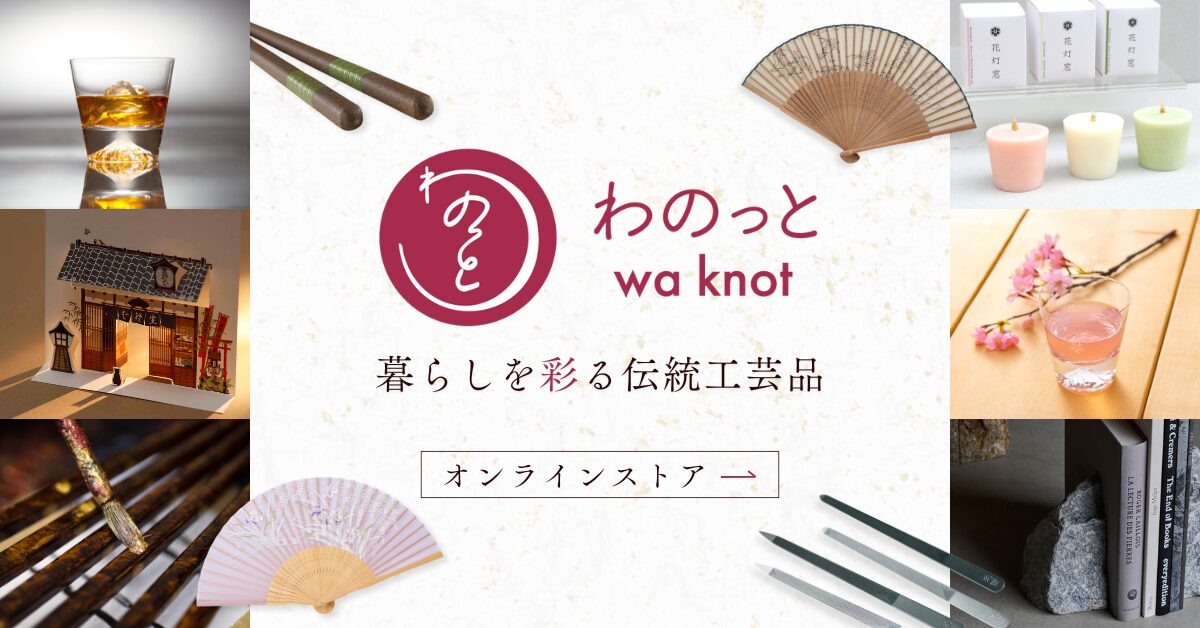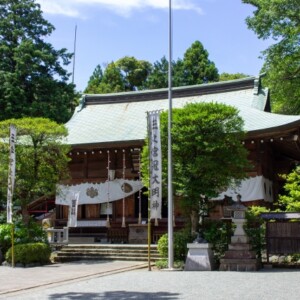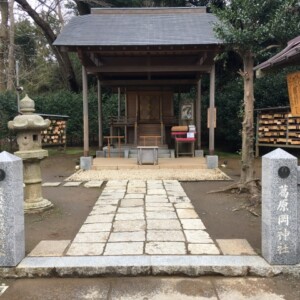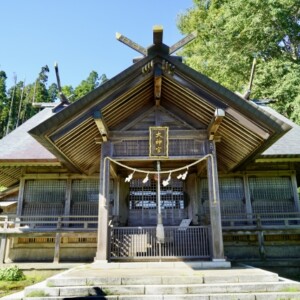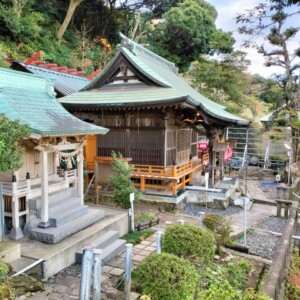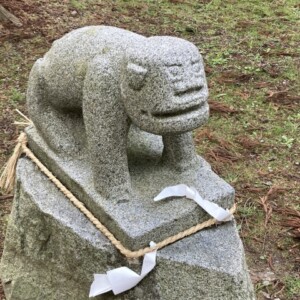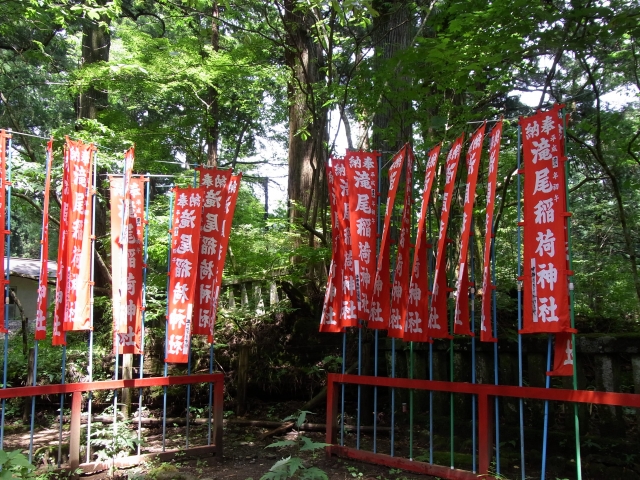
Takio Jinja|Complete guide to the hidden power spot and highlights of the Nikko Futaarasan Shrine Annex, and information on worshipping at the shrine.
Takio Shrine, located in Nikko City, Tochigi Prefecture, is a hidden power spot that has long been worshipped as a separate shrine of Futaarayama Shrine. In contrast to the bustling Nikko Toshogu Shrine, this quiet sanctuary nestled in a deep forest welcomes visitors with numerous attractions such as a torii gate for testing one’s luck, a bamboo branch for matchmaking, and a 300-year-old sacred tree.
Outline and basic information about Takio Shrine
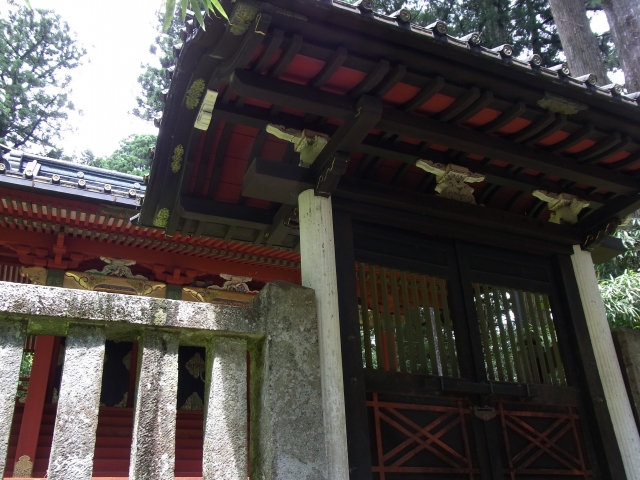
Takio Shrine is a separate shrine of Futaarayama Shrine, located approximately 1 km west of the Futaarayama Shrine headquarters in a thickly forested area, and is dedicated to Tagorihime-no-mikoto, the consort of the main deity of Futaarayama Shrine, Ohonamuchi-no-mikoto. The official name of the shrine is “Futaarayama Shrine Separate Shrine Takio Jinja” and is known locally as “Takino-o Jinja.
History and Origin
The shrine was founded by Kobo Daishi in the 11th year of the Konin Era (820). This shrine was built to worship Mt. It used to be called “Nyotai Chugu” and together with Hongu and Shingu (Futaarasan Shrine) were called Nikko Sanja (three shrines).
It is said that Kobo Daishi built Takio Gongen on Mt. Meoto, and that the shrine was built to worship Mt. Also, as one of the three Nikko Sansha Gongen shrines, along with the Annex, Hongu, and Shingu of the Nikko Futaarasan Shrine, it has played a central role in Nikko’s religious beliefs.
Deities and Benefits
The main deity of Takio Shrine is Tagori-hime-no-mikoto, the consort of the main deity of Futaarasan Shrine, Ohonamuchi-no-mikoto, who is worshipped as the god of water. Tagorihime-no-Mikoto is known as the goddess of water and is believed to bring good luck in marriage, fertility, and easy childbirth.
Behind the main shrine, there is a huge “Sanbonsugi” cedar tree, a stone torii gate, a stone lantern, and a stone fence, which is said to be the place where Tashin-hime-no-Mikoto descended. This place is considered the most sacred space in Takio Shrine and is visited by many worshippers.
Highlights of Takio Shrine
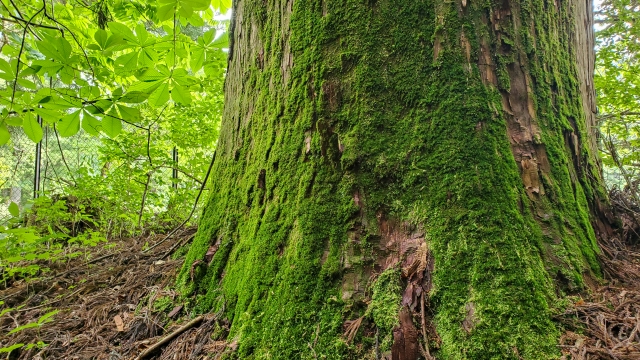
The precincts of Takio Shrine are dotted with a wide variety of sights, from historic buildings to natural beauty. As a separate shrine of Futaarayama Shrine, Takio Shrine has a prestigious appearance while creating a mysterious atmosphere unique to its deep mountain location.
Architectural and Structural Attractions
The Bengu-Takio Shrine Main Hall (Sangensha-nagare-zukuri, copper-tile roof), Bengu-Takio Shrine Karamon (Ichiken Ichidohira Karamon, copper-tile roof), Bengu-Takio Shrine Worship Hall (Sangen x Sanken, Iri-moya, copper-tile roof), Bengu-Takio Shrine Toromon (Sanken Ichidohiro-mon, copper-tile roof), and Bengu-Takio Shrine Torii (three stone Myojin torii gates) have been designated as nationally important cultural properties.
The main hall is a three-room shrine with a flowing roof, and the two-legged flat karamon gate was rebuilt in 1713 (Shoutoku 3), and the surrounding stone pavement was also constructed at that time. The back wall of the main hall has a door so that the deity Mt.
The stone pavement and stone steps in the precincts of the shrine still bear the appearance of the Edo period, inviting visitors to enter the Shinto sanctuary. The beautiful vermilion paint and the exquisite colorful decorations of the main shrine building, which appears after passing through the tower gate, contrast beautifully with the deep green of the forest.
The Beauty of Nature and Scenery
As a mountain shrine surrounded by rich nature, Takio Shrine offers beautiful scenery in each of the four seasons. A group of giant cedar trees covers the shrine grounds, creating a solemn atmosphere as a Shinto sanctuary.
The sacred tree at the back of the shrine grounds is particularly impressive. The three sacred cedars in a row are called “Takio Sanbon-sugi” (three cedars in a row). The current cedar is the second generation, and is 250 to 300 years old. What is surprising is that the earlier sacred tree, which fell 300 years ago, is still intact and mossy. This sight tells how the deity has become one with nature over the years.
The autumn leaves are beautiful in fall, and the snow-covered precincts create a fantastic atmosphere in winter. The natural beauty of the shrine, which shows different expressions depending on the season you visit, is one of the major attractions of Takio Shrine.
Shiraito Falls and Kobo Daishi’s training site
Shiraito Falls, located just to the left of the shrine entrance, is the first attraction that greets visitors. This famous waterfall spans the Tengu River and is approximately 10 meters high. It is said to be the place where Kobo Daishi practiced asceticism.
The famous waterfall over Tengu stream, about 10 meters high, is said to be the place where Kobo Daishi practiced his asceticism. In 1486, Empress Doko of Shogoin in Kyoto visited Nikko, and in her travelogue “Kaikoku Zoki,” she wrote the following waka poem. The poem, “The end of the ties that bind through the ages, is the white thread of a tree in this waterfall basin,” indicates that Nikko has been a popular spot for many people since the olden days.
The Shiraito Falls are also the origin of the name of Takio Shrine, which is a sacred place where Kobo Daishi Kukai is said to have practiced asceticism, and many worshippers still lay their hands on the falls today. The pure sound of the waterfall purifies the hearts of worshippers and prepares them for the divine realm.
Guide to Worship and Visitation
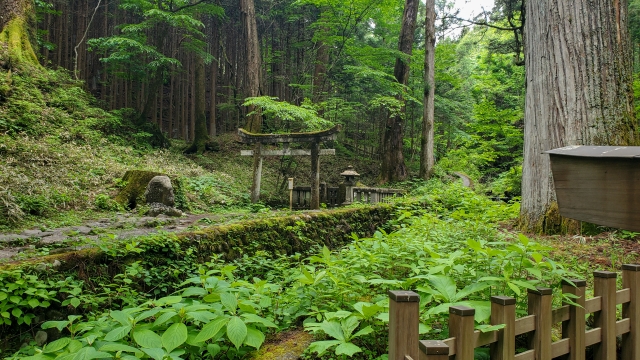
Worship at Takio Shrine can be conducted in a serene and tranquil setting in the sacred space of a deep forest. Unlike bustling tourist destinations such as Nikko Toshogu Shrine, a rare experience awaits you where you can slowly face the gods in an environment of tranquility.
Worship Etiquette and Manners
At Takio Shrine, visitors follow general shrine etiquette. First, bow before passing through the torii gate and walk down the path, avoiding the center of the path. After purifying your hands and mouth at the hand- and mouth-wash basin, go to the hall of worship and pray in the manner of “ni-ai ni clap, ni-ii clap, ni-ii clap, ni-ii clap.
When visiting the shrine, it is important to keep in mind that it is a mountain shrine and to respect the natural environment. Since the shrine grounds are a sacred place, please refrain from loud conversations, and try to worship quietly.
The approach to Takio Shrine is a cobblestone mountain path, so it is recommended that visitors wear comfortable walking shoes and allow sufficient time for their visit.
Torii gate for testing one’s luck and bamboos for marriage
One of the special features of Takio Shrine is the “Torii (gateway) for testing one’s luck. It is known as the “luck-testing torii,” and is believed to bring good luck if a stone is thrown three times through the small hole in the torii and even one stone passes through the hole.
It is said that if you throw three pebbles and the number of pebbles that pass through the round hole in the middle of the forehead of the torii, you will try your luck! If you pass through even one hole, consider yourself quite lucky. Many visitors try their luck at this test, which is a popular and unique way to enjoy Takio Shrine.
The precincts of the shrine are also home to “en-musubi no bamboos,” which are said to bring people together when they make a wish on the bamboos, attracting visitors seeking a good match. Since Tashimihime-no-mikoto is believed to be the god of marriage, this shrine is especially popular among female worshippers.
The sacred tree “Takio Sanbon-sugi” and power spots
It is said to be the most sacred place within the precincts of Takio Shrine. Standing in front of the three cedars within the stone walls, one can certainly feel the warmth of the clear air, or is this power? The three Takio cedars are said to have the strongest power in Takio Shrine.
There are numerous other power spots scattered throughout the shrine grounds. The “Koseki” stone, which is said to be blessed with a child and to bring about a safe delivery, is popular among those wishing for a safe delivery or a childbirth. There is also a place where fresh water called “Sake-no-Spring” gushes out, which has been cherished as sacred water since ancient times.
Behind the Sake Spring, there is a “Kossei-ishi,” a stone that is said to bring children into the world. It is also said to be beneficial for easy childbirth. Surrounded by a stone wall, there are various stones on the large stone that should be out of reach. It is said that by visiting these power spots, one can receive various blessings.
Access/Use Information
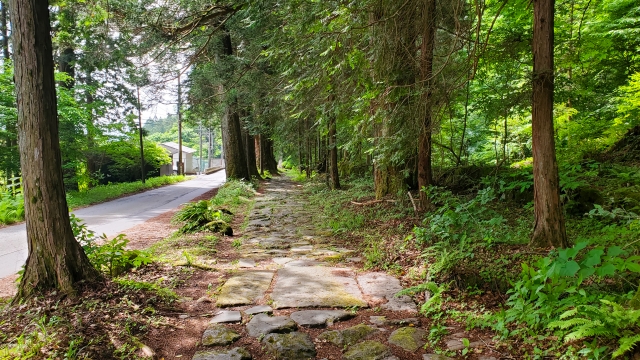
There are two ways to access Takio Shrine: on foot or by car. Each has its own characteristics, so we recommend that you choose the one that best suits your physical strength and time.
Traffic Access
There are two ways to access Takio Shrine: on foot from Nikko Toshogu Shrine or Futaarasan Shrine, or by car.
If on foot, the location is in the mountains, a 30-minute walk from the right side of the grounds of Toshogu Shrine and Futaarayama Shrine. From the grounds of Nikko Futaarasan Shrine, enter the historic site exploration path and walk along the stone-paved approach to the shrine. Along the way, you will see the Shiraito Waterfall and various historical sites, which will enhance your desire to visit the shrine.
If you are driving, there is a parking lot right next to the shrine, but please note that the road is narrow and it is difficult for cars to pass each other, so those who are not confident in their driving skills are advised to walk to the shrine for blessings. From Utsunomiya City, take Nikko Kaido Route 119 north through downtown Nikko, and after crossing the Oya River, turn right onto Prefectural Route 247 and continue north along the river just before the bridge. Follow the narrow road, which is only about the width of a car, and park your car in the parking lot in front of the Takio Takatoku Suijinja Shrine, and walk up the stairs of the Takio Shrine.
If you use public transportation, take the Tobu Bus from JR Nikko Station or Tobu Nikko Station, get off at the “Kamihashi” bus stop, and walk to the destination.
Hours of Admission, Fees, and Parking Information
Admission fee: Free Hours: There are no set hours for visiting Takio Shrine, which is open 24 hours a day. However, since the shrine is located in the mountains, it is recommended to visit during daylight hours for safety reasons.
As for parking, free parking is available for several cars near the shrine, but the number of cars is limited due to the parking: neighborhood use situation. In addition, the road to the parking lot is very narrow, making access by large vehicles difficult.
As a precaution when visiting the shrine, the road from the bus stop to Takino Shrine is not a paved road. Please wear shoes and clothing that are comfortable for walking on the mountain path, such as sneakers. Wearing comfortable walking clothes and shoes is strongly recommended for visiting the shrine.
Also, since the area around Takio Shrine is in the mountains, there are no restrooms. It is recommended that you go to the restrooms around Toshogu Shrine or Futaarasan Shrine before going to the shrine! It is one of the most important preparations to use the restroom in advance.
<Address> 2310-1 Yamauchi, Nikko-shi, Tochigi 321-1431
Reference site
Takio Shrine|Experience and Sightseeing Spots – Nikko City: https://www.nikko-kankou.org/spot/24


